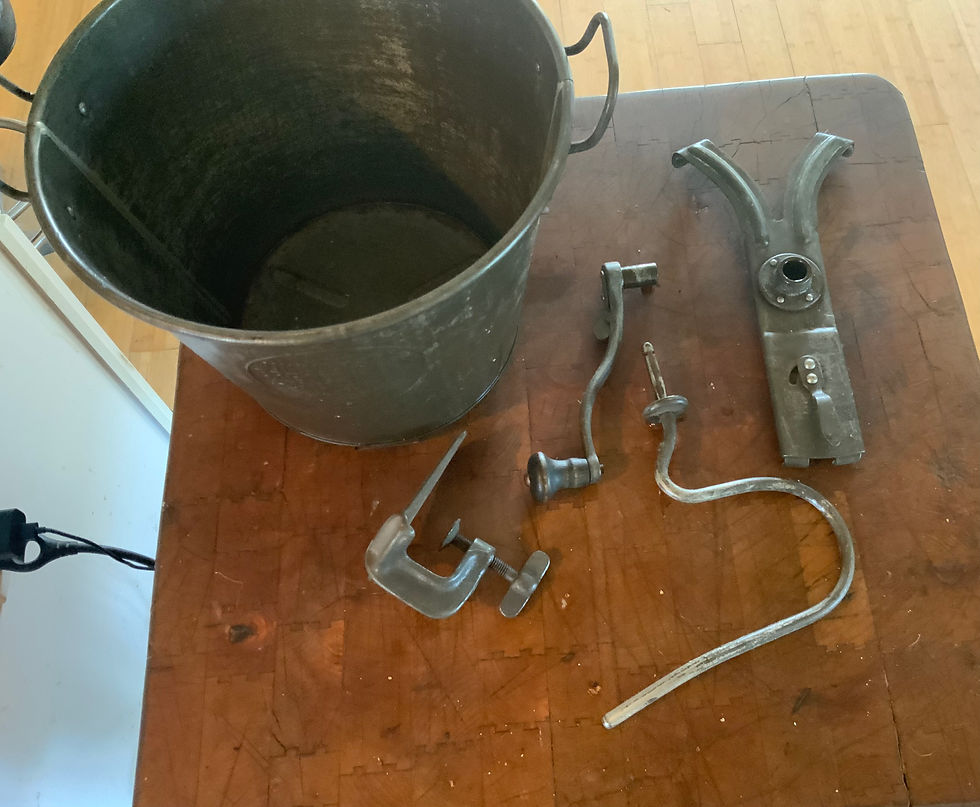The “Universal No 4” Bread Maker
- muleequestrian

- Jul 26
- 3 min read
Updated: Aug 28
Back in 1862, a company was founded from several different manufacturers and became known as Landers, Frary, and Clark.
The company manufactured a wide variety of products over the years, food scales, coffee grinders, cake mixers, bread makers, coffee pots, percolators, tableware, toasters, sad irons for clothing, and at the turn of the 20th century they produced kitchen items and gadgets that were electrified. Landers, Frary & Clark also produced stainless steel bull-nose rings, vacuum bottles, window hardware, ice skates, mouse traps, can openers, corkscrews, straight razors, aluminum cookware, and thousands of other products. Many of the company's items were marketed under the brand Universal.

I’m primarily interested today in the Number 4 Universal bread maker. This little bucket has traces of tin plating on it, but it’s mostly worn away. But this item is clean and still functions much as it did when it was first sold.
The patent dates on this kitchen aid suggest 1904, and was probably featured at the World’s Fair in St Louis, Missouri along with other “modern” inventions.
This little bucket has traces of tin plating on it, but it’s mostly worn away. But this item is clean and still functions much as it did when it was first sold.

For me, this bucket represents a type of “freedom” from the electrical needs of today’s kitchen. Imagine if we experience a tornado, a coronal mass ejection, or rolling blackouts of the power grid. Where I live in Maine, power outages are fairly common in winter as the snow laden tree branches fall across power lines. With hand powered tools such as this, I can still provide decent food for myself in the event of such an emergency.

So exactly how does this archaic thing work ? Believe it or not, this thing actually has the instructions embossed into the lid. It reads:
Put in all liquids first, then flour
Turn 3 minutes
Raise in pail
After raising turn until dough forms a ball
Take off cross piece lift out dough with kneader

I used this today as I have many times before. Not because of a power outage, but for “nostalgia.” Not to mention that I like to stay in practice with some of my emergency prep equipment in case anything does happen. I’m a firm believer that if a person stays dry, warm, well fed within reason, and has shelter — they’ll be somewhat immune to making snap judgments concerning their general well being. Sound decisions come about by not running from one panic to another. And this is just one of many little things I do to make sure I’m using logic instead of emotional rhetoric when things turn bad temporarily.

Personally I don’t wait around for the dough to rise and then beat it back down again. I’ve found that grinding my own grains by hand (see another post about the bluestone grain mill) this is an unnecessary step. I do a single rise because the dough is so dense. The second rising of the dough is for modern flours that are much finer, and tend to form air pockets in the final baked product. The punching down and second rising helps eliminate these pockets so you can make a good sandwich bread.

I put my dough in a pregreased loaf pan with flour to help release the bread when it’s finished baking.
The Universal Bread Makers are no longer in production since LFC went out of business in the 1960’s or so. But they can be found for a reasonable price on many websites that sell old antiques. They’re generally in the $50 and up range and you should take your time to find a useable one in good condition. In a pinch these can provide you with nutritious bread during emergency situations.
Up next is how I bake this bread in a cast iron Dutch oven in an outdoors fire pit. Another good tip to be prepared for emergency situations is.



Comments